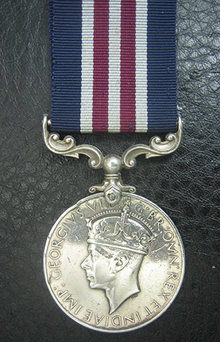
MILITARY MEDAL, G.VI.R. ‘808757 GNR. G. STEPHENSON. R.A.’
M.M. London Gazette 26 August 1941: ‘In recognition of distinguished services in the field.’
George W. Stephenson from Bishop Auckland, Co Durham, was a regular soldier serving with the 23rd Field Regiment, Royal Artillery, when the Second War broke out, having joined the Royal Artillery on 28 May 1937.
23rd Field Regiment Royal Artillery, consisting of 60, 89, 90 and 100th Batteries, served with 3 Infantry Division when it moved to France as part of the B.E.F. on 29 September 1939. It transferred to 51 (Highland) Infantry Division on 5 March 1940. Seeing heavy fighting with the French 10th Army during May and June 1940, 51st Division was cut off from the rest of the B.E.F. during the evacuation of Dunkirk. Heading initially to La Havre in the hope of evacuation from there, they were surrounded at St Valer-en-caux and after heavy fighting, the remnants of the Division surrendered on 12 June 1940 and Gunner Stephenson was taken prisoner. It was reported that just 1 Officer and 10 men from 23 Regiment made it back to England with remnants of the BEF. The following outstanding website gives a very large amount of detail on events:
https://51hd.co.uk/history/valery_1940
Stephenson specifically sais he was captured in a wood about 8 km from Le Harve but how it came that he was captured outside La Harve, which was 59 km from St Valery is not known; though it should make an interesting research project. 23rd Regiment were not Part of Ark Force that was cut off from the rest of the Division at La Havre on 10 June and were evacuated between 11 and 12 June. Presumably elements of the Division were spread out over a wide distance so this could be a reason or perhaps he escaped from nearer St Valery and was headed to La Havre when captured.
Regardless, from being captured, Stephenson leaves details in his MI9 report, of escaping after a 3 day march. He then goes on to tell how he was recaptured at Lens on 28 July 1940 and imprisoned at Arras but escaped again 3 days but was recaptured again before he reached Lille. He escaped yet again on 25 September 1940, finding ‘asylum with a Frenchwoman’ in Faches, just outside Lille. He left Fachese on 26 January 1941 and on 2 February 1942 crossed the demarcation line between Occupied France and Vichy France, near Castillion. He then headed to Marseilles by train. He then stayed at the Sailors Mission, Marseilles and then Hippolyte du Fort, leaving there on 5 April. St Hippolyte du Fort was a French prison near Nimes but Stephenson does not seem to have been imprisoned there, so its not clear why he was here but at this time the Vichy authorities seem to have been turning a blind eye to escapee’s at this time. However he then crossed the Pyrenees before arriving at Barcelona. Given a ticket to Madrid by the Consul, he was arrested o the train before reaching there and was imprisoned for 12 days and was then sent to Gibraltar for repatriation to England. Gunner Stephenson arrived at Liverpool on 16 May 1941, 11 months after his initial capture, having spent the majority of that time on the run or in safe houses.
Some time later Stephenson joined 9 Commando, as noted on the superb commandoveterans website:
“The death of Gnr. George W. Stephenson (No.9 Cdo) of Bristol, Avon., was announced in Commando Association newsletter 117 issued September 2003”
http://www.commandoveterans.org/GeorgeStephenson9Commando
No other details are known regarding Stephenson’s service with 9 Commando but presumably joined not long after returning to England. He was awarded a M.M. on 26 August 1941, almost certainly from escaping, as most non recommendation M.M.’s to escapers were; the MI9 reports themselves serving as recommendations…….
SEE PDF FOR FULL WRITE UPCondition suspension re-pinned and edge bruising. A most interesting medal and story, certainly worthy of further detailed research.